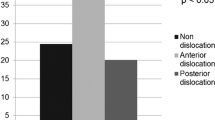Abstract
Several studies support the concept that, for optimum range of motion in THA, the combined femoral and acetabular anteversion should be some constant or fall within some “safe zone.” When using a cementless femoral component, the surgeon has little control of the anteversion of the component since it is dictated by native femoral anteversion. Given this constraint, we asked whether the surgeon should use the native anteversion of the acetabulum as a target for implant position in THA. Forty-six patients scheduled for primary THA underwent CT scanning and preoperative planning using a computer workstation. The native acetabular anteversion and the native femoral anteversion were measured. Prosthetic femoral anteversion was measured on the workstation by three-dimensional templating of a straight-stemmed tapered implant. The mean of the sum of the native acetabular anteversion and native femoral anteversion was 28.9°; however, 17% varied by 10° to 15° and 11% by more than 15°. The mean of native femoral anteversion and prosthetic femoral anteversion was 13.8° (range, −6.1°–32.7°) and 22.5° (range, 1°–39°), respectively. Based on our data, we believe the surgeon should not use the native acetabular anteversion as a target for positioning the acetabular component.





Similar content being viewed by others
References
Bargar WL, Bauer A, Borner M. Primary and revision total hip replacement using the Robodoc system. Clin Orthop Relat Res. 1998;354:82–91.
Jamali AA, Deuel C, Perreira A, Salgado CJ, Hunter JC, Strong EB. Linear and angular measurements of computer-generated models: are they accurate, valid, and reliable? Comput Aided Surg. 2007;12:278–285.
Jamali AA, Mladenov K, Meyer DC, Martinez A, Beck M, Ganz R, Leunig M. Anteroposterior pelvic radiographs to assess acetabular retroversion: high validity of the “cross-over-sign”. J Orthop Res. 2007;25:758–765.
Lee YS, Oh SH, Seon JK, Song EK, Yoon TR. 3D femoral neck anteversion measurements based on the posterior femoral plane in ORTHODOC system. Med Biol Eng Comput. 2006;44:895–906.
Lucas DH, Scott RB. The Ranawat Sign: a specific maneuver to assess component positioning in total hip arthroplasty. J Orthop Techn. 1994;2:59–61.
Malik A, Maheshwari A, Dorr LD. Impingement with total hip replacement. J Bone Joint Surg Am. 2007;89:1832–1842.
Murray DW. The definition and measurement of acetabular orientation. J Bone Joint Surg Br. 1993;75:228–232.
Murtha PE, Hafez MA, Jaramaz B, DiGioia AM 3rd. Variations in acetabular anatomy with reference to total hip replacement. J Bone Joint Surg Br. 2008;90:308–313.
Stem ES, O’Connor MI, Kransdorf MJ, Crook J. Computed tomography analysis of acetabular anteversion and abduction. J Skel Radiol. 2006;35:385–389.
Sugano N, Noble PC, Kamaric E. A comparison of alternative methods of measuring femoral anteversion. J Comput Assist Tomogr. 1998;22:610–614.
Tonnis D, Heinecke A. Current Concepts Review: Acetabular and femoral anteversion: relationship with osteoarthritis of the hip. J Bone Joint Surg Am. 1999;81:1747–1770.
Widmer KH, Zurfluh B. Compliant positioning of total hip components for optimal range of motion. J Orthop Res. 2004;22:815–821.
Yoshimine F. The safe-zones for combined cup and neck anteversions that fulfill the essential range of motion and their optimum combination in total hip replacements. J Biomech. 2006;39:1315–1323.
Acknowledgments
We thank Andrea Hankins, BS, Sutter Institute for Medical Research, for her help in preparing this manuscript.
Author information
Authors and Affiliations
Corresponding author
Additional information
Each author certifies that he or she has no commercial associations (eg, consultancies, stock ownership, equity interest, patent/licensing arrangements, etc) that might pose a conflict of interest in connection with the submitted article.
Each author certifies that his or her institution approved the human protocol for this investigation, that all investigations were conducted in conformity with ethical principles of research, and that informed consent for participation in the study was obtained.
This work was performed at The Sutter Institute for Medical Research and at UC Davis.
About this article
Cite this article
Bargar, W.L., Jamali, A.A. & Nejad, A.H. Femoral Anteversion in THA and its Lack of Correlation with Native Acetabular Anteversion. Clin Orthop Relat Res 468, 527–532 (2010). https://doi.org/10.1007/s11999-009-1040-2
Received:
Accepted:
Published:
Issue Date:
DOI: https://doi.org/10.1007/s11999-009-1040-2




